Menus
- A rare honor
- Engine damage the order of the day
- Jawa engine is more compact in comparison
- Jawa 350 V4 a bit chubby
- Bill Ivy – a godsend for Jawa
- Ivy died at the age of 26
- The end of the Jawa V4 era
- Test drive at the Goodwood Festival of Speed
- The Jawa is mechanically reliable
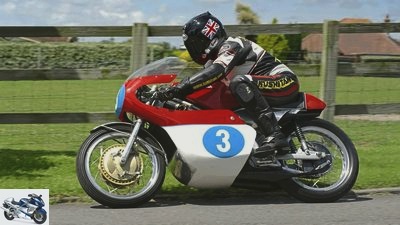
Alan Cathcart
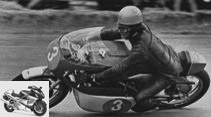
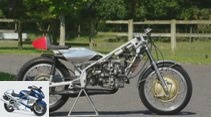
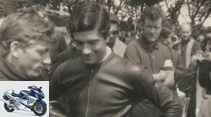
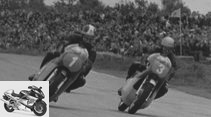
14th photos
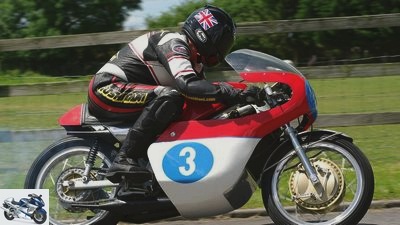
Alan Cathcart
1/14
Technical miracle: the Jawa 350 V4
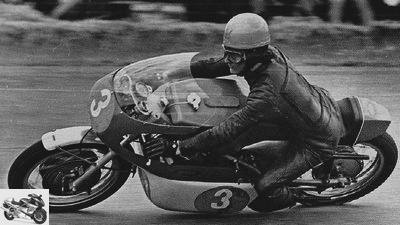
Alan Cathcart
2/14
Ivy in Assen: After taking the lead in the meantime, everything looks like a win, but dropouts let the Jawa fall back to second place.
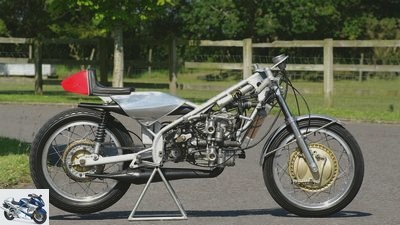
Alan Cathcart
3/14
The engine acts as a load-bearing element in the rigid chassis. The poor simplex drum brake at the rear was Ivy’s special request.
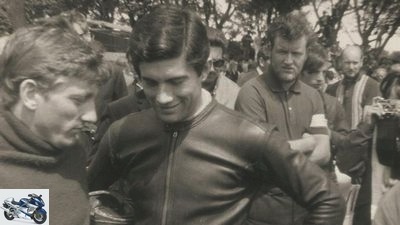
Alan Cathcart
4/14
The big opponents among themselves: Bill Ivy and Giacomo Agostini
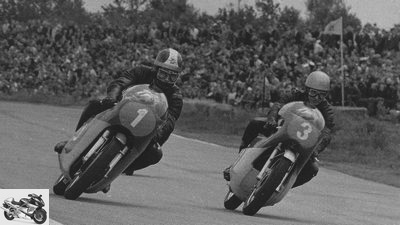
Alan Cathcart
5/14
Agostini (# 1) and Ivy in a duel at the Dutch TT run in Assen in 1969
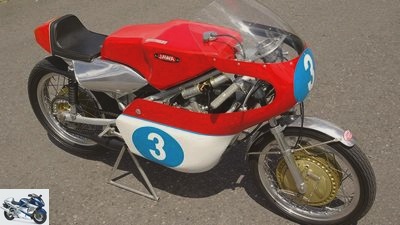
Alan Cathcart
6/14
Flat and delicate – yet even 1.80-meter pilots can fold up on the Jawa 350 V4.
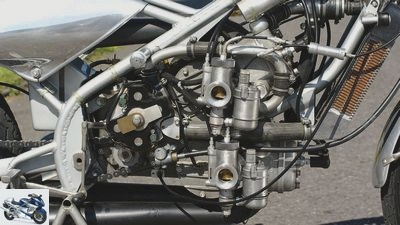
Alan Cathcart
7/14
Two easy-to-use throttle cables each lead to a distributor (right and left), and from there a second pair of cables to the carburettors on one side.
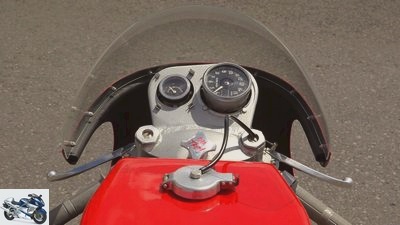
Alan Cathcart
8/14
The green area of the water temperature begins at 90 degrees, the red area of the rev counter at 13500 rpm.
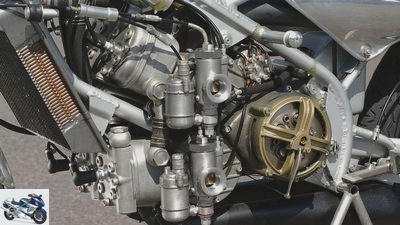
Alan Cathcart
9/14
The powerful dry clutch characterizes the left side of the engine, together with two of the total of four Amal 27 carburettors with Dellorto float chambers.

10/14

Alan Cathcart
11/14
To be able to drive with one of three built Jawas is truly an honor.
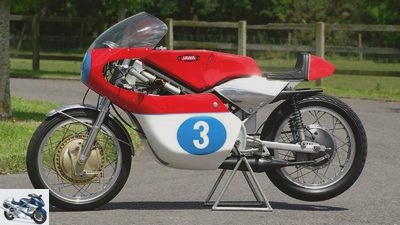
Alan Cathcart
12/14
Two Girling suspension struts support the oval tubular steel swing arm on the frame.

Alan Cathcart
13/14
Shift: Ivy with a dry Jawa tank at the GP in Hockenheim.
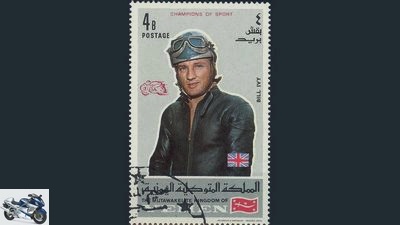
Alan Cathcart
14/14
The incredible talent Bill Ivy had a fatal accident at the age of only 26. Seen here on a Yemeni postage stamp.
Exit with the Jawa 350 V4
A rare honor
Content of
Despite all the difficulties, Jawa managed to heat up the financially strong competitors Honda and MV Agusta with the initially fragile Jawa 350 V4. The ride with one of the only three copies built is definitely an honor.
During the glorious era of road racing in the 1950s and 1960s, Czechoslovakia was the only country behind the Iron Curtain that seriously defied the supremacy of the Italians and Japanese. At least in the prestigious higher displacement classes. Just like Husqvarna, Royal Enfield, FN, BSA and others, the company founded in 1929 by FrantiŠek Janecek was Jawa an offshoot of the arms industry. As one of the largest two-wheeler markets in Europe in the 1930s with more than 50 national manufacturers, Czechoslovakia was considered one of the breeding grounds for road racing before World War II, and Jawa played a key role here. But after 1945 the land found itself on the "wrong side of the iron curtain" again. Jawa was nationalized, and in 1949 it was forcibly merged with its competitor CZ. Nevertheless, the enthusiasm for motorsport lived on, and the two brands developed their own road and off-road racing cars. In times of the burgeoning two-wheeler boom, use in Grand Prix racing should make the quality of the products known worldwide.
Buy complete article

Exit with the Jawa 350 V4
A rare honor
Stastny brings first GP victories for Jawa
Jawa’s big moment finally came in 1961, when the legendary works driver FrantiŠek Stastny took second place in the 350 World Championship after winning both the opening run in Hockenheim and the final race in Sweden. Further GP victories in the following years and several fourth places in the overall World Championship rankings made Jawa a thorn in the side of the much financially stronger teams from Honda and MV Agusta. But those did not have to struggle with all the logistical problems that bothered all the teams behind the Iron Curtain: Obtaining visas, providing foreign exchange in hard currency – a constant nightmare.
Engine damage the order of the day
Towards the end of the 1960s, the Jawa technicians around Zdenek Tichy recognized the new direction in road racing: the two-stroke racers increasingly replaced the four-stroke twins, which was also reflected in the model range of series bikes. In the beginning, slot-controlled 250 and 350 singles were preferred, but Tichy and his team began working on air-cooled V-Twins with rotary valve control in 1966. These provided the template for the technology of the water-cooled 350 cm³ V4 engine, Type 673, which made its debut at the Dutch TT in Assen in 1967. It turned out to be vulnerable, however, and went up three times in training and ultimately in the race. One of the main reasons was probably the inability to get modern, high-quality bearings and steel of suitable quality. Failures due to engine damage were therefore the order of the day.
Jawa engine is more compact in comparison
Nonetheless, the Jawa V4 followed a pioneering principle that was very similar to that of the Yamaha rotary valve V4. But the smaller angle of only 35 degrees between the cylinder pairs made the Jawa engine more compact and enabled a more aerodynamic front. It had four separate crankshafts, one pair being connected to an intermediate shaft by means of a splined shaft via a large, straight-toothed intermediate gear. This transfers the power to the clutch and drives the ignition system and the water pump. This unique design allows each individual crankshaft to be dismantled without removing the engine. Steel connecting rods with roller bearings are used, forged pistons with a single, hard chrome-plated ring provide a compression ratio of 16: 1. The V4 was water-cooled from the start, initially using the thermosyphon principle, and from 1968 a water pump was installed. Last but not least, the ingenious design of the silencer ensures an impressive 68 hp at 13,200 rpm. The power is transmitted via a massive dry clutch and seven-speed gearbox.
Jawa 350 V4 a bit chubby
The advanced motor hangs in a double-loop tubular steel frame and acts as a load-bearing element. A 240 millimeter drum brake at the front and a 220 millimeter drum brake at the rear slows the 138 kilogram dry weight somewhat "chubby" Jawa 350 V4 – Yamaha’s 250cc V4 weighs only 118 kilograms, Agostini’s 350 MV Agusta weighs 128 kilograms. After a fourth place at the home GP in Brno, but also many subsequent failures, they remembered: For 1969, nails were made, the type 673A got a new, flatter frame, a transistor ignition and a separate oil tank under the seat, from which now the crankshaft bearings could be supplied directly in addition to the 1:25 mixture. With a measured 260 km / h the Jawa was definitely fast, now hopefully also stable so that the newly engaged British star pilot Bill Ivy (only 1.57 meters, almost 50 kilograms) could race for victories. In 1968 he finished second behind his team-mate Phil Read in the 125cc and 250cc classes, but now, after the Yamaha withdrawal, without a works contract.
Bill Ivy – a godsend for Jawa
By chance, he came into contact with FrantiŠek Stastny through his friend Luigi Taveri, who brought him into conversation at Jawa. Ivy is said to have announced that he had received an annual salary of $ 28,000 at Yamaha, but he was ready to start at Jawa in 1969 for $ 20,000. In the end, however, there was far less money (in three installments), but four Jawa 350 single-cylinder racers. During the first tests, Bill immediately felt at home on the Jawa 350 V4, but soon discovered that the winding stretches of the powerful and fast machine were not so. The season opener on May 4th in Jarama, Spain, was very promising: After initial problems (the Jawa only ran on three pots for a long time), the engine cracked, Ivy plowed through the field and was just about to overtake third-placed Visenzi when the engine went out again . Incidentally, Agostini won undisputed. But just a week later in Hockenheim things looked different. The fast course was made for the Jawa, Ivy came second, just five seconds behind winner Agostini. But he was also lucky: with a stuttering engine, he jerked to the finish in front of the enthusiastic audience – with a bone-dry tank. The team had calculated the amount of fuel incorrectly because no one had ever turned the gas so hard and also ended the race. Was that the turning point? At the next run in Assen, Ivy even led before Ago at times, but the Brit who was struggling with misfiring was overtaken again. Victory for Ago in the race, but at least second place in the championship table for Ivy.
Ivy died at the age of 26
At last it seemed to be competitive. The race at the Sachsenring on July 13th, however, would go down in history ingloriously, because the day before, during free practice in the pouring rain, Ivy fell on the run-out lap. He slid into a wall not protected by bales of straw after losing his helmet while sliding. He later died in hospital from his severe head injuries, at the age of just 26. The subsequent investigation had shown that the crankshaft bearing of the lower left cylinder had got stuck. In preparation for the trip to the pit, Ivy had already opened the chin strap with his left hand, which is why he could not pull the clutch of the Jawa 350 V4 fast enough.
The end of the Jawa V4 era
Jawa competed for the rest of the season with substitute drivers like Jack Findlay and Silvio Grassetti as well as the ancestral Stastny, and at the Yugoslavia GP in Opatija Grassetti even won its first victory with the Jawa 350 V4. Later a victory followed in Salzburg, but it was foreseeable that Jawa would withdraw from street sports in order to concentrate more on the speedway races. Of the only three V4 racers built, one fell into the hands of its builder Zdenek Tichy, who only had it superficially restored to an exhibition piece before it changed hands to the French racing driver Jean-Francois Balde, who initiated a ten-year restoration to put the Jawa back in its absolute original condition. In 2002 the bike was finished and ready for the first ride. "An important moment, like the first time", Balde winked mischievously. He then drove the Jawa for almost five years at all kinds of events and classic races, and the engine never caused problems. Then the farewell came. "I am not a collector", admitted Balde.
Test drive at the Goodwood Festival of Speed
The Jawa 350 V4 then spent a few years in the possession of Bernard Richards before it finally came into real collector’s hands, those of the bustling museum owner Sammy Miller. And Sammy let me move this precious rarity on his little course around the museum and soon after at the Goodwood Festival of Speed. Even when I was sitting up, it was surprising how generous the space was, even for me, who was a head taller than little Bill Ivy. Neither the handlebars nor the hand lever are adjustable, but that fits, and the operation of the throttle is also very pleasant – easy and precise. The start-up procedure is pretty straightforward if you follow the procedure before and during the push-off in second gear, and after all four cylinders have come to life, the V4 has to be warmed up patiently for a long time. The gearshift (right) is a bit stiff, gear changes require force and therefore time. The clutch, on the other hand, works easily and precisely, if you let it slip, the engine stays happy in tight turns. Pressure from the very bottom isn’t the V4’s forte – nothing happens below 8,000 rpm and the driver shouldn’t even think about switching below 12,500 rpm. It took some time on the Goodwood circuit to get the most out of it, and although I never really got into seventh gear, I was certainly really fast on the long straight in sixth gear. Amazing! Especially when you know that the large 240 double duplex drum brake at the front safely brakes the load.
The Jawa is mechanically reliable
The handling is incredibly precise, thanks to the narrow tires the Jawa 350 V4 easily steers in without looking nervous. The 68 hp come in at 13,200 rpm, I definitely don’t turn it higher today in order not to risk mechanical catastrophes. The left hand still rests on the lever, always ready to disengage in an emergency. But today the Jawa is mechanically reliable. Back then, too, she was on the right track, and perhaps in the following year with a similarly talented driver like Ivy it would have been more than second place in the World Championship behind Agostini. The innovative V4 engine deserved it.
Related articles
-
Artist Autumn exit 2007 Further to cloudy Somewhere in the southeastern Dolomites there is supposed to be a legendary pass that overshadows everything…
-
Paulovits 18 pictures Imre Paulovits 1/18 Former racing driver István Nyitray drove motocross and enduro more than 50 years ago. Imre Paulovits 2/18 In the …
-
Trial Jawa put under the microscope by Gunter Ruttloff
markus-jahn.com 14 pictures markus-jahn.com 1/14 Trial-Jawa by Gunter Ruttloff. markus-jahn.com 2/14 The fine art of improvisation and solid craft …
-
Artist Autumn exit 2004 Waterworld Sometimes it just happens. Continuous rain. Land under. Knee deep. And you have no choice but to keep your eyes open….
-
Frank Ronicke Model history Jawa 350 The time machine Contents of The decades passed, but the Jawa 350 braced itself with its 1947 as …
-
Jawa Perak (2020) – New model in bobber garb
Jawa 8 pictures Jawa 1/8 The new Jawa Perak will hit the streets in 2020. Jawa 2/8 However, it is only offered in Asia. Jawa 3/8 The …
-
Jawa 650 Style – Technical data
Jawa 650 Style technical data Overview Testing Technical specifications engine Number of cylinders, type 1, engine power 35.4 kW / 48.1 PS at 6,500 rpm…
-
IO Hawk Exit Cross E-Scooter: Kick scooter test off-road
Jiri Pekarek 22 pictures Jiri Pekarek 1/22 stones like this are one size too big for the Exit Cross. Mona Pekarek 2/22 He beats himself on the meadow …
-
VF 1000 F2 self-made Honda V4 exit
www.factstudio.de 8 pictures factstudio.de 1/8 picture gallery: Honda V4 exit. factstudio.de 2/8 V4 Hondas in all variations: From the noble VF 1000 …
-
Ducati 1199 Panigale – first exit
Ducati 33 pictures Ducati 1/33 New super sports car from Ducati for 2012: Ducati 1199 Panigale. Ducati 2/33 New super sports bike from Ducati for 2012: Ducati …